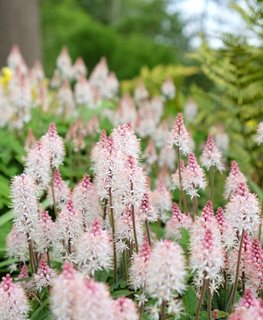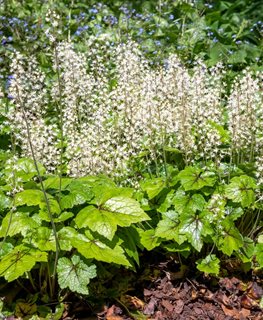HOW TO GROW & CARE FOR FOAMFLOWER IN YOUR GARDEN
Use this tough low-maintenance perennial for difficult shady areas
'Cutting Edge' foamflower (Tiarella hybrid). Photo: Proven Winners
Foamflower is a hardy herbaceous perennial with dainty flower spikes and attractive foliage. Named for the foamy white or pink flowers that appear in spring, this North American native can be found growing in shady woodlands and along moist stream banks.
Also known as tiarella, false miterwort, heartleaf foamflower, or Allegheny foamflower, this diminutive carefree plant makes a good ground cover for difficult sites such as deep shade where little else will grow. Related to coral bells (Heuchera), foamflower is useful in small spaces, containers, mass plantings, or naturalized in a woodland setting. Here’s how to grow and use foamflower in your landscape.
On this page: Basics | Planting | Care | Pictures | Frequently Asked Questions | Landscaping Ideas
On this page:
- BASICS
- HOW TO PLANT FOAMFLOWER
- FOAMFLOWER CARE
- FOAMFLOWER VARIETIES
- FREQUENTLY ASKED QUESTIONS
- DESIGN IDEAS
FOAMFLOWER BASICS
Botanical name:
Tiarella spp.
Plant type:
Herbaceous perennial
Zones:
3-9
Exposure:
Partial to full shade
Habit:
Compact spreading or clumping habit
Height/Spread:
6 to 12 inches tall, 12 to 24 inches wide, with flower spikes reaching up to 18 inches tall
Bloom time:
Most varieties bloom from mid to late spring, though some can bloom in early spring or into summer
Flowers:
White or pink flower buds open to dense clusters of tiny star-shaped white or pale pink flowers. Blooms are produced along upright spiky stems, creating a frothy appearance. The light fragrance of the flowers is attractive to insect pollinators.
Foliage:
The attractive foliage is heart-shaped or deeply lobed, with some varieties producing leaves that resemble oak, maple, or fig leaves. Coloring is green, with leaf patterns in shades of dark red, burgundy, or black. In milder climates, plants may be evergreen or semi-evergreen, acquiring variable coloring in fall and winter.
Toxicity:
Foamflower is not considered toxic to humans or pets, though the ingestion of any part of a non-edible plant may cause mild digestive upset.
HOW TO PLANT FOAMFLOWER
When to plant:
Plant foamflower during milder weather in spring or fall to avoid transplant shock from extreme cold or heat.
Where to plant:
Choose a site with partial, full, or dappled shade and moisture retentive soil. Plants can tolerate some direct morning sun. Foliage color may fade in full shade.
How to plant:
Loosen soil in the planting area and amend with compost or other humus rich organic matter. Dig a hole slightly wider and as deep as the root ball. Remove plant from the nursery container and loosen roots if potbound. Place in the hole so the top of the root ball is level with the surrounding soil to allow for mulch. Fill in the hole with soil, tamp down gently to remove air pockets, and water thoroughly. Water regularly until plants are established. Space plants 12 to 18 inches apart.
FOAMFLOWER CARE

'Cutting Edge' foamflower (Tiarella hybrid). Photo: Proven Winners
Temperature:
Foamflower is cold hardy in most zones and performs best in regions with mild to moderate summer temperatures.
Soil:
Provide rich, well-drained soil with a slightly acidic pH of 5.5-6.5. Amend soil with compost or other rich organic matter before planting. For containers, use a high quality all-purpose potting mix.
Amendments & fertilizer:
Plants need little or no supplemental fertilizer. In early spring before plants show new growth, apply a balanced slow-release fertilizer according to instructions. Plants can also be mulched around the base with compost.
Watering:
Foamflower prefers moderate water. Keep soil evenly moist but not soggy. Avoid overwatering to prevent root rot. Water more frequently during heat and dry spells. Foamflower is somewhat drought tolerant once established.
Pruning:
Cut back dead foliage in spring before new growth appears. Deadhead flower stalks when they are finished blooming to improve overall appearance.
Dividing:
Clumps can be divided every few years to improve air circulation and water flow to the roots. Runners can be removed and transplanted to new areas.
Pests and diseases:
When grown in the right conditions, foamflower is free of most pests and diseases. Pests can include black vine weevils, mealybugs, root weevils, slugs or snails. Diseases include root rot, rust, and powdery mildew.
FOAMFLOWER VARIETIES
FREQUENTLY ASKED QUESTIONS
Is tiarella invasive?
Plants spread through rhizomatous runners, but are not considered invasive. If clumps become overgrown, they can be divided and moved in spring.
How long does tiarella bloom?
Tiarella generally blooms from 4 to 8 weeks, though bloom time can vary according to variety, climate and weather conditions.
Is Tiarella cordifolia edible?
Tiarella has no known edible uses, and is not considered toxic, though mild stomach upset may occur if leaves are ingested.
Do deer eat tiarella?
Foamflower is considered deer resistant, though any plant may be susceptible to deer browse if other food sources are scarce.
Does foamflower spread?
Many varieties spread quickly through rhizomatous runners, forming a mat-like ground cover. Others such as Wherry’s foamflower form clumps and don’t spread through rhizomes.
FOAMFLOWER LANDSCAPING TIPS
There are many ways to use foamflower in your landscape. Here’s how:
For borders and landscapes:
Grow foamflower in a mixed border, shaded rockery, native or woodland gardens, as edging or a ground cover.
For slopes and hillsides:
Mass along a slope to help stem erosion.
For containers:
Feature foamflower in a container by itself or alongside other plants with similar growing needs.
- Mass by a shady pond or stream alongside other moisture loving plants.
- Include in a native garden with other plants native to your region.
- Plant in a rain garden with other moisture-loving plants that thrive in shade such as hostas, ferns, sedges, and leopard plant (Ligularia).
- Mass a spreading variety along a shady slope or hillside to help stem erosion.
- Naturalize as a ground cover in a woodland shade garden in combination with trees, shrubs, and perennials for a layered tapestry effect.
- Use as edging along a pathway or at the front of a mixed border.
- Plant underneath trees or shrubs to help suppress weeds.
Companion plants: Tiarella pairs well with many other woodland favorites. Plant alongside ferns, coral bells (Heuchera), hostas, astilbe, columbine, Siberian bugloss (Brunnera), lungwort (Pulmonaria), sedges, and spring-blooming bulbs.
RELATED:
Ideas for an Enticing Cottage Garden
21 Easiest Flowers for Beginners
16 Surprisingly Drought-Tolerant Plants
20+ Cottage Garden Plants & Flowers









